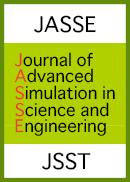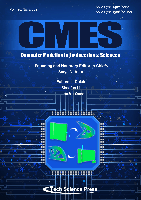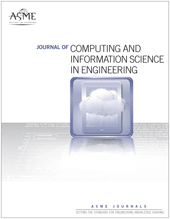
Journal of Advanced Simulation in Science and Engineering
Scope & Guideline
Pioneering Insights in Computational Modeling and Beyond
Introduction
Aims and Scopes
- Simulation Methodologies:
The journal emphasizes the development and refinement of simulation techniques, including numerical methods, machine learning approaches, and advanced computational algorithms. - Interdisciplinary Applications:
It covers a broad range of applications in fields such as material science, biomedical engineering, environmental science, and aerospace, showcasing how simulation can solve complex real-world problems. - Emerging Technologies:
The journal pays special attention to the integration of emerging technologies like artificial intelligence, additive manufacturing, and virtual reality in simulation practices. - Data Analysis and Modeling:
Research focusing on data analysis techniques, including big data and machine learning applications, is a core area, highlighting the importance of data-driven simulation. - Theoretical Foundations:
The journal also delves into the theoretical underpinnings of simulation methods, exploring mathematical models and their implications in scientific research.
Trending and Emerging
- Machine Learning Integration:
There is a significant increase in the application of machine learning techniques to enhance simulation accuracy and efficiency, indicating a trend towards data-driven methodologies. - Advanced Material Simulations:
Research focusing on the simulation of advanced materials, including additive manufacturing and molecular dynamics, is gaining traction, reflecting its relevance in modern engineering. - Healthcare and Biomedical Applications:
Emerging themes in healthcare simulation, particularly in medical training and nuclear medicine, underscore the journal's commitment to addressing pressing societal challenges. - Environmental and Disaster Management Simulations:
Papers addressing disaster response systems and environmental simulations indicate a growing emphasis on using simulation for societal benefits and crisis management. - Virtual and Augmented Reality in Simulation:
The incorporation of virtual and augmented reality into simulation methodologies is increasingly prevalent, showcasing the journal's focus on cutting-edge technologies that enhance user experience and interaction.
Declining or Waning
- Traditional Numerical Techniques:
There appears to be a waning focus on classical numerical methods without integration of modern approaches, as newer techniques gain prominence. - Generalized Applications:
Papers that address broad or generalized applications without specific case studies seem to be less frequent, signaling a shift towards more specialized and detailed research. - Basic Theoretical Research:
There is a noticeable decline in publications focused solely on basic theoretical research, as practical applications and interdisciplinary studies become more favored. - Static Simulations:
Static or less dynamic simulation studies are less represented, with a growing demand for simulations that incorporate real-time data and dynamic modeling. - Non-Interdisciplinary Approaches:
Research that does not integrate insights from multiple disciplines is becoming less common, highlighting a trend towards interdisciplinary collaboration.
Similar Journals

International Journal of Gaming and Computer-Mediated Simulations
Advancing Research in Digital InteractionsThe International Journal of Gaming and Computer-Mediated Simulations, published by IGI Global, serves as a pivotal platform for the dissemination of cutting-edge research in the realms of gaming and computer-mediated interactions. Established in 2009, it has consistently provided a scholarly space for innovative discussions around the implications, advancements, and societal impacts of gaming technologies and simulations. With an impressive impact factor as it continues to grow within the Q3 category of Computer Science Applications, this journal ranks #491 out of 817 in Scopus, highlighting its significance within an evolving discipline. Featuring contributions from both established and emerging scholars, the journal aims to bridge theoretical knowledge and practical application, thereby nourishing the academic pursuits of researchers, practitioners, and students alike. Access to the journal's rich content is critical for those striving to keep pace in this dynamic field, making it an essential resource for anyone invested in the future of gaming and computer-mediated environments.

Nonlinear Engineering - Modeling and Application
Exploring Innovations in Nonlinear SystemsNonlinear Engineering - Modeling and Application is a premier journal dedicated to advancing the fields of engineering, modeling, and simulation, published by De Gruyter Poland Sp. z o.o. since 2012. With an impressive impact factor reflected in its prestigious rankings—Q2 in Chemical Engineering and Miscellaneous Engineering and Q3 in Computer Networks and Communications—this journal serves as an invaluable resource for researchers and practitioners seeking to explore the intricacies of nonlinear systems and their applications. As an Open Access journal since 2019, it ensures that groundbreaking research is readily available to the global community, fostering collaboration and innovation. Situated at the forefront of its field, Nonlinear Engineering provides high-quality, peer-reviewed articles that contribute to understanding complex phenomena in various engineering disciplines, making it an essential publication for those eager to stay on the cutting edge of technology and research.

Applications in Engineering Science
Connecting Ideas, Advancing Engineering SolutionsApplications in Engineering Science is an innovative and highly-regarded open-access journal, published by ELSEVIER in the United Kingdom, focusing on the cross-disciplinary fields of Civil and Structural Engineering, Computational Mechanics, and Mechanical Engineering. Since its inception in 2020, the journal has rapidly established a solid reputation, landing in the Q2 quartile category across multiple engineering disciplines, reflecting its commitment to quality and relevance in the rapidly evolving engineering landscape. With Scopus rankings placing it prominently in the 66th percentile for Computational Mechanics and 58th for Mechanical Engineering, it serves as a vital platform for researchers, professionals, and students alike to share advanced methodologies, innovative applications, and interdisciplinary insights. The journal is committed to fostering open access to cutting-edge research, empowering readers worldwide to stay abreast of significant technological advancements and practical applications in engineering science.

CMES-COMPUTER MODELING IN ENGINEERING & SCIENCES
Empowering Innovation through Modeling & SimulationCMES-COMPUTER MODELING IN ENGINEERING & SCIENCES is a premier journal published by Tech Science Press, dedicated to advancing knowledge in the fields of computer science applications, modeling and simulation, and software engineering. With an impressive convergence of research from 2000 to 2024, this journal stands out as a vital resource for researchers, professionals, and students alike, fostering innovation and collaboration in computational methodologies. The journal currently holds a Q3 category ranking in multiple disciplines according to the latest metrics, including Scopus, which reflects its growing significance in the academic community. By providing a platform for high-quality research and open discourse, CMES aims to enhance the understanding of complex systems through effective modeling techniques and computational tools. Despite its current classification under open access, the journal remains a cornerstone for those looking to deepen their expertise in cutting-edge computational engineering and science.

Advanced Modeling and Simulation in Engineering Sciences
To Transform Engineering with Advanced Simulation Techniques.Advanced Modeling and Simulation in Engineering Sciences is a premier open access journal published by SpringerNature, dedicated to advancing the field of engineering through innovative modeling and simulation techniques. Since its inception in 2014, the journal has consistently provided a platform for cutting-edge research, contributing significantly to the body of knowledge across diverse scientific domains. With a robust impact in the academic community, it ranks in the Q2 category in Applied Mathematics and Computer Science Applications and the prestigious Q1 category in Engineering (miscellaneous), reflecting its high quality and relevance. Positioned in the United Kingdom, it is accessible to a global audience, promoting open access that allows researchers, professionals, and students to freely disseminate and access crucial findings. By bridging the gap between theory and practical applications, the journal serves as an invaluable resource for those engaged in the fields of engineering, modeling, and simulation, fostering collaboration and innovation for future advancements.

World Journal of Engineering
Pioneering Insights Across Diverse Engineering DisciplinesWorld Journal of Engineering, published by EMERALD GROUP PUBLISHING LTD, stands as a premier platform for disseminating high-quality research across various engineering disciplines. Since its inception in 2014, the journal has built a reputation for its rigorous peer-review process and commitment to advancing knowledge in the fields of Civil and Structural Engineering, Electrical and Electronic Engineering, Geotechnical Engineering, Mechanical Engineering, and Mechanics of Materials. With its categorization in the Q3 quartile across multiple engineering domains and notable Scopus rankings, the journal positions itself as a valuable resource for researchers, professionals, and students seeking to stay abreast of innovations and critical developments in engineering. While the journal currently operates under a subscription model, its comprehensive scope ensures that it remains a vital reference point for contemporary engineering challenges and solutions throughout the United Kingdom and beyond.

Advances in Science and Technology-Research Journal
Unlocking Innovations, Shaping the FutureAdvances in Science and Technology-Research Journal, published by Lublin University of Technology in Poland, is an esteemed open access journal that has been enriching the scholarly landscape since 2012. With an ISSN of 2080-4075 and an E-ISSN of 2299-8624, this journal is dedicated to disseminating cutting-edge research across Computer Science, Engineering, Environmental Science, and Materials Science. Recognized within the Q3 quartile in 2023 across various fields, it holds respectable rankings in Scopus, including Rank #184 in General Engineering and Rank #122 in Materials Science. The journal’s commitment to open access fosters wider dissemination and engagement within the scientific community, making it a vital resource for researchers, professionals, and students alike. As the fields of science and technology continue to evolve, this journal serves as a vital conduit for innovative ideas and collaborative research, inviting contributions that push the boundaries of knowledge.

International Journal of Interactive Design and Manufacturing - IJIDeM
Unleashing Potential through Innovative Manufacturing PracticesInternational Journal of Interactive Design and Manufacturing (IJIDeM), an esteemed publication by SPRINGER HEIDELBERG, has carved a niche in the domains of Industrial and Manufacturing Engineering and Modeling and Simulation. Established in 2008, this journal serves as a critical platform for disseminating cutting-edge research and practical advancements related to interactive design and innovative manufacturing processes. With an impact factor that places it within the Q2 and Q3 quartiles of respective categories, and Scopus rankings affirming its relevance, IJIDeM invites contributions that explore the crossroads of design, technology, and engineering. Researchers, professionals, and students alike will find valuable insights and collaborations through its pages, making it a vital resource for anyone seeking to enhance their understanding of interactive design principles in manufacturing contexts.

JOURNAL OF COMPUTING AND INFORMATION SCIENCE IN ENGINEERING
Advancing the Frontiers of Computing and EngineeringWelcome to the JOURNAL OF COMPUTING AND INFORMATION SCIENCE IN ENGINEERING, a premier publication from ASME that focuses on the dynamic intersection of computing and engineering disciplines. With an ISSN of 1530-9827 and E-ISSN 1944-7078, this journal serves as a critical platform for disseminating innovative research and advancements in areas such as Computer Graphics, Computer-Aided Design, Software Engineering, and Industrial Manufacturing. The journal spans from 2001 to 2024 and has been recognized for its excellence, boasting impressive Scopus rankings including Q1 in Industrial and Manufacturing Engineering and Q2 in both Computer Graphics and Computer Science Applications. It offers a unique opportunity for researchers, professionals, and students to engage with high-impact studies and present their contributions to a diverse audience. As a member of the esteemed ASME family, this journal promotes open dialogue and fosters the growth of knowledge in technical fields, while emphasizing practical applications and interdisciplinary collaboration. Join us in exploring the forefront of computing and engineering through rigorous research and insightful articles that drive innovation and progress.

Modelling is a distinguished open access journal published by MDPI since 2020, dedicated to advancing the field of computational modeling across various scientific disciplines including Computer Science, Engineering, and Mathematics. With its base in Switzerland, the journal aims to foster a collaborative environment for researchers and practitioners while providing a platform for high-quality research on modeling and simulation techniques. As of 2023, it has garnered respectable rankings, achieving Q3 in Computer Science and Mathematics, and Q2 in Engineering, with notable Scopus values indicating an increasing impact within the academic community. Modelling not only publishes innovative research findings but also encourages the dissemination and discussion of emerging methodologies, making it a vital resource for scholars seeking to contribute to and expand the frontiers of knowledge in their respective fields. As an open access journal, it promotes unrestricted access to research outputs, ensuring greater visibility and impact for researchers and students alike.